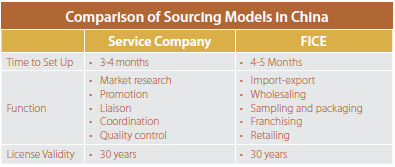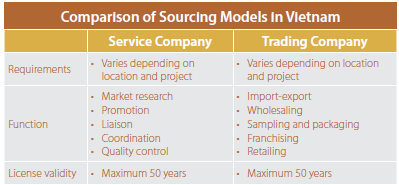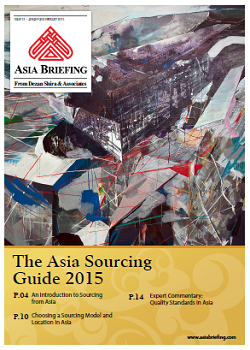By Chris Devonshire-Ellis
Dezan Shira & Associates
China and Vietnam both allow foreign entities to operate representative offices (ROs). Because these types of offices cannot undertake any commercial or industrial activities, receive payment in local currency, or manage export/import activities, they are considered an ‘indirect’ method of managing a sourcing operation.
‘Direct’ sourcing requires that a foreign firm establish an office from which they will be able to directly manage procurement. This entails that the company’s office be in control of various levels of the sourcing operation and be able to receive payment in the country’s local currency. Although this option inevitably necessitates a greater financial and legal burden for the investing company, it is an effective means of ensuring higher performance levels from an Asia-based sourcing operation. Unlike representative/liaison offices, which have similar functions across China and Vietnam, the types of direct platforms a firm can operate vary significantly from country to country.
Here, we discuss how these types of ‘indirect’ and ‘direct’ sourcing platforms function in China and Vietnam.
China
Representative Office
Many traditional buyers in China tend to lean towards the representative office (RO) structure, purely driven by the preference of not having to inject registered capital. For this reason, the RO is often recognized as a “safe” and “cheap” model, and the best option for a China office whose primary purpose is to explore market possibilities.
For ROs, expenditure is funded directly by the overseas headquarters at regular intervals, typically on a monthly or quarterly basis. Conversely, for a direct sourcing entity such as a service company or foreign-invested commercial enterprise (FICE), most of this funding comes instead from the registered capital, which is committed right at the beginning. Moreover, the cost of financing the on-going activities of an RO is very different than a service company or a FICE, since the RO will be taxed on top of expenses while the service company or FICE will deduct costs and pay tax on profits. Consequently, the perceived flexibility offered by the no-capital RO structure may only apply when the RO’s business scope is sufficient to satisfy the to satisfy the needs in China of the overseas parent company.
 RELATED: Entry Strategy Advisory from Dezan Shira & Associates
RELATED: Entry Strategy Advisory from Dezan Shira & Associates
Foreign-Invested Commercial Enterprise
A large proportion of companies that are ready to undergo formal registration in China may already be familiar with the market and its suppliers, and many will already have established relationships with their Chinese suppliers. In this case, the added benefits of a wider business scope provided by a FICE could prove much more valuable and self-sustainable than the traditionally “safe” and “cheap” RO.
For these businesses, a FICE model is usually preferred because it allows for the widest possible scope for sourcing (including import/export and the ability to make domestic purchases in RMB). In China, many smaller domestic suppliers are far less willing to tranact in foreign currencies, so sourcing through a FICE structure will effectively broaden the selection of local suppliers because the company will be able to buy in China in RMB before consolidating and exporting. Since its business scope is wide, a FICE’s minimum registered capital requirements will be higher than those of a service company (varying between different locations).
Service Company
The service company model also has its own merits. Since a service company cannot trade products directly, the compliance involved is generally quite low and it can also play the part of an intermediate quality control and service agent for HQ. Although the same effect can be achieved with an RO, this model does have the added capability of receiving
commission or other service revenues in RMB. As such, this model can be more tax efficient than an RO, and is a good interim solution for companies that are not yet ready to tackle the Chinese VAT system and other operational compliance requirements.
Supply Chain Control vs. HR Risks
To obtain a comfortable level of control and assurance over the production and delivery of products, foreign buyers should employ reliable staff on the ground to manage quality control, supplier selection and liaison activities, price negotiations and market research. As Chinese markets mature and price competition intensifies, foreign companies not yet in China will need to continually assess whether it is still affordable to function via long-distance with their Chinese suppliers, or whether more substantial operational control is needed.
The RO, service company and FICE structures can all be used to hire local employees in China, although there are some limitations for ROs. For senior level Chinese staff, there is a general perception that direct employment relationships are more stable and provide additional security. For many companies in the sourcing business, staff may be required to be based at multiple locations around the country (such as on-site at the factory, travelling for quality control purposes, or short term supervision projects). Since the Chinese social insurance system is still managed on a regional basis, and since contribution rates and local practices can differ across cities, cross province social insurance payments for employees can become a headache for the employer.
Complexity, Compliance and Tax Efficiency
The changing trends in global procurement and the growing competitiveness of other supplying nations mean that the FICE model has become much more pertinent, as it allows for two-way traffic in both the inbound and outbound sourcing of products. For example, many SMEs use China as a procurement hub to consolidate regional sourcing activities within Asia, since China’s infrastructure is generally recognized to be more developed and more efficient than countries such as India, Indonesia or Thailand. The FICE model also makes it possible for companies to explore the potential of adapting their products or services for domestic consumption. An initial sourcing platform, established as an FICE, might in this case become the perfect starting point to begin wholesale, and maybe retail, activities in China.
However, it should be noted that with the added flexibility and complexity of a FICE, the operational and tax compliance requirements are also higher than the two other models. Applying for VAT export rebates, ensuring that VAT receipts are all verified, controlling inventory, dealing with customs and import duties – these all become the FICE’s responsibility once a direct sourcing model is employed. Competent internal staff, as well as the support of reliable external consultants, are key in establishing a successful business.
Remaining tax compliant is also important because the Chinese authorities tend to keep a closer eye on the activities of foreign companies. Therefore, foreign companies should note the different types of taxes and filings that can apply to their various trading, commission and service activities. From a transfer pricing point of view, statutory filings will need to be completed each year to disclose the sales activities between the company and its headquarters.
 Quality Standards in Asia: Regional Differences and Long-Term Trends
Quality Standards in Asia: Regional Differences and Long-Term Trends
Vietnam
Representative Office
As with China, Vietnam’s ROs are unable to conduct any revenue-generating activities, and can only indirectly interact with Vietnamese businesses. They are mostly used for market-research purposes and to ensure that a parent company’s sourcing operation is functioning properly.
Service Companies and Trading Companies
Foreign companies establishing a more direct sourcing platform in Vietnam have two primary options: a service company and a trading company. Both are classified as limited liability companies (LLCs) and are able to make profits and issue local invoices in VND.
Of the two, trading companies are granted greater control over procurement in Vietnam. The main function of a service company is the provision of services to third parties. Foreign investors involved in sourcing activities use this type of company for activities such as market and supplier research, quality control, product development, design and logistical support services. Trading companies, on the other hand, can engage in import and export activities, as well as domestic distribution (i.e., retail, wholesale and franchising trade activities) in Vietnam. They are therefore the most direct means of managing a sourcing operation.
Summary
Vietnam is an attractive sourcing market due to the vast wealth of its agricultural industry, political stability, and growing consumer market. The country is still highly competitive in labor-intensive industries, as labor costs remain at a low base. The minimum wage rise of 13-15 percent in 2014 reached only awkward phrasing US $100-145 per month. In terms of future demographics, Vietnam awk. Compared to neighboring Thailand, its labor force of 53.7 million as of Q2 2014 is projected to grow rather than shrink between now and 2050.
While several legal structures can be used as a necessary building block in a successful Vietnam sourcing strategy, it can often be difficult for companies (particularly those new to Vietnam) to decide on the optimal solutions needed to support their mainland sourcing activities. With so many quality control and trading agents available that offer one-stop sourcing services, and with business-to-business (B2B) online platforms allowing direct contact with suppliers, many will argue it is just as effective to utilize a subcontracting agreement and intermediate parties. Although this is a perfectly workable option, to be more competitive, many SMEs now require an on-the-ground presence either to gain better control of their supply chain, or to be able to continue servicing their international customers who have also entered the Vietnamese market.
Foreign SMEs that consider Vietnam an unknown market may prefer the low capital risks associated with an RO. Meanwhile, the wider business scope and operational flexibility that a service company offers may also be tempting.
At the other extreme, an overseas company that has been purchasing directly from Vietnam for many years may wish to take full control through a trading company. However, foreign firms may be deterred by the heavy operational complexity of such an entity; a trading company that exports is directly involved in Vietnam’s complex VAT system and has to comply with customs requirements. Since Vietnam does not require a set amount of money to be invested, SMEs usually do not put a large amount of registered capital into the subsidiary company. However, companies must ensure that they put in enough money to handle any business expenses arising from operations.
|
|
![]()
 Sourcing From China
Sourcing From China
In this issue of China Briefing Magazine, we outline the various sourcing models available for foreign investors and discuss how to decide which structure best suits the sourcing needs of your business. Perhaps the most important factors to consider when choosing a sourcing structure are your staffing requirements, your need for operational flexibility, and which option offers the greatest cost efficiencies.
Establishing Your Sourcing Platform in India
In this issue of India Briefing, we highlight the advantages India possesses as a sourcing option and explore the choices available to foreign companies seeking to create a sourcing presence here. In addition, we examine the relevant procurement, procedural and tax duty concerns involved in sourcing from India, and conclude by investigating the importance of supplier due diligence – a process that, if not conducted correctly, can often prove the undoing of a sourcing venture.
 Developing Your Sourcing Strategy for Vietnam
Developing Your Sourcing Strategy for Vietnam
In this issue of Vietnam Briefing Magazine, we outline the various sourcing models available for foreign investors – representative offices, service companies and trading companies – and discuss how to decide which structure best suits the sourcing needs of your business.






